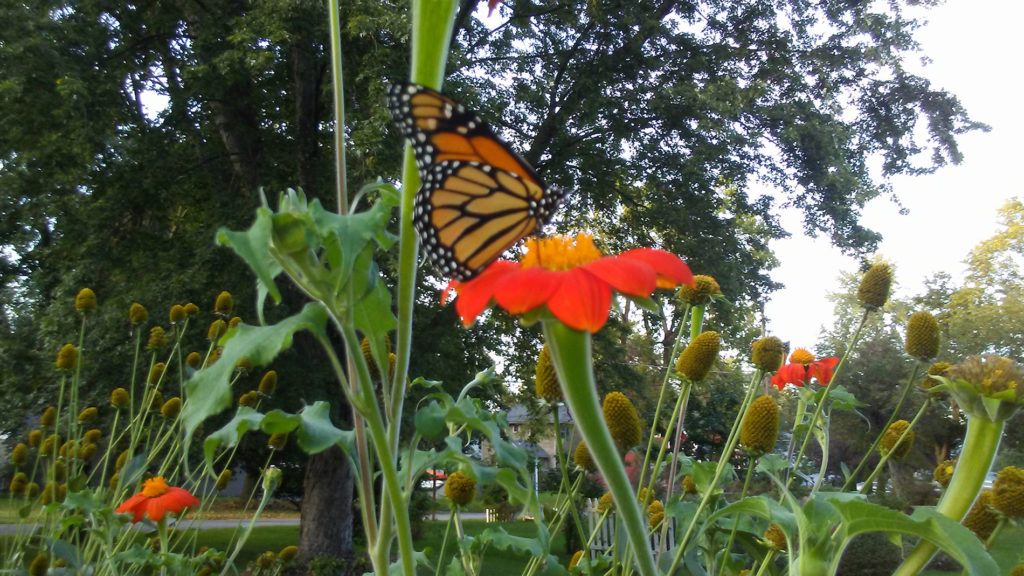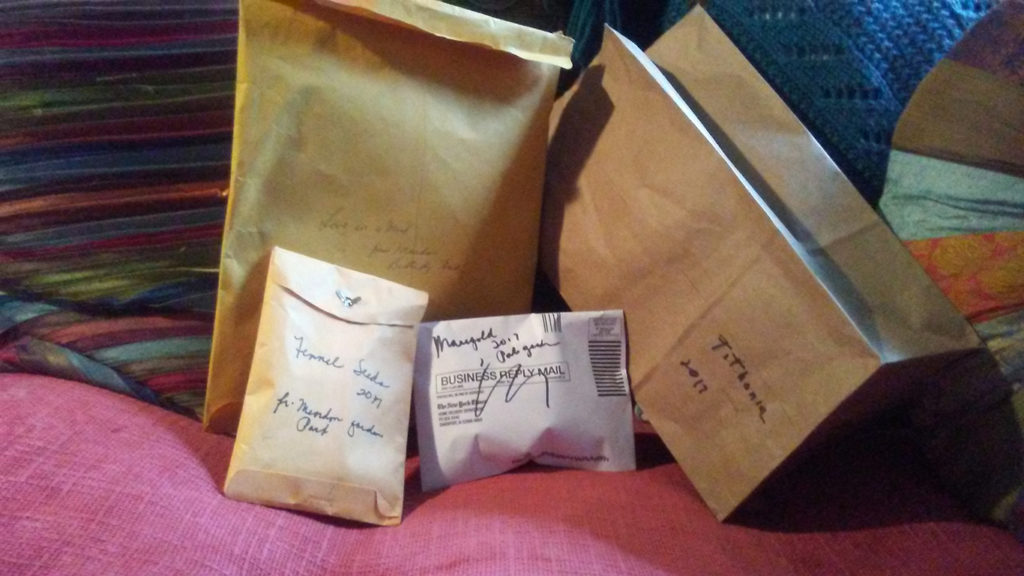The Village Gardener: Putting the garden to bed

Above: A monarch on Tithonia…one of the seeds collected.
Photos Georgeanne Vyverberg

by Georgeanne Vyverberg –
So much depends on winterizing the gardens, but too often the process is filled with dread and the thought of much work. I think that’s because people believe it must be done in a day or two. The weather has turned to beautiful sunny, wind filled days and it’s hard to get motivated to spend precious days like this working in the gardens and yard. However, I insist that it can be the pleasant end to a summer of beautiful flowers and tasty vegetables, and specifically NOT done in a single day. A few minutes to an hour or two a day is really all it takes. Honest! The trick is to start …preferably in mid-October, but it can last way into November or until it’s a snow-covered landscape. Okay let’s get out there and start! But where you ask? Good question, but YOU have been in those gardens all summer and I have a feeling you know where in YOUR garden that might be.
Let’s start with the vegetable garden, which more than likely is pretty well finished, although I am still picking beans from my third planting and they are still flowering as I write this in late October. Begin clearing all the plants that are brown and shriveled. If anything was diseased or moldy, place those remains in a trash bag to be thrown away and not in the compost. Compost everything else. I am assuming you have a compost heap of lawn clippings and leaves and, garden waste. Even if you have a small yard the benefit of a compost heap is beyond measure. When the veggie garden is cleared of plants and weeds and if you have time it’s a perfect time to incorporate rotted manure and compost into at least a few small beds. Next Spring you will need only a few minutes to plant carrots, lettuce, kale, and other salad greens.
Finally cover the garden with old hay or better yet leaves that have been mowed. They will protect the soil and even add more nutrients as they slowly break down over winter. To keep them from blowing away a few tree branches or boughs can help.
Next let’s take a long look at the flower gardens. Stand aside and try to remember all those mental notes you promised yourself you would write down “somewhere, sometime, as soon as you went inside, etc.” Were the hollyhocks too tall and over shadowing the Lantana below it? Did you buy something you couldn’t live without, and then returned home to find that in mid-July there was nowhere to put it, but you shoved it in someplace…the wrong place? I confess to being guilty as charged, but what is a gardener to do? It was on sale! Well now’s the time to remedy at least some of those mistakes. But first let’s clean up that garden. My practice has been to cut down anything that is brown and obviously done for the season, but I like to leave anything still green alone except perhaps to trim. Green signifies that plants are still processing the sun’s energy and making valuable food for roots and stems. I find it’s a good practice to walk through and along the flower gardens daily or every few days, always with clippers in hand and cut back and prune as I go. It takes so little time really.
Then there are those plants needing extra winterizing care. Roses for example. I must admit I am new to roses these past couple of years. I never wanted to bother with them. My friends talked endlessly about aphids and black spot and spent a lot of time fussing over them. With 3 acres of gardens and a barn full of horses and goats and chickens I simply didn’t want plants that needed that much coddling. Last year I bought one of those shrub roses that bloom all summer and into Fall. I was smitten and had four more planted by late summer. How, did I resist for so long? So, I am learning as I go. This is what I have learned at least about getting them ready for the onslaughts of winter. If there were any black spot on those leaves (only one of my five were affected) then once they drop those leaves, clean them and any mulch underneath and discard in the trash. Once things get into November Its good to mulch the roses up to 10-12 inches of the crown and stem. Again, use mulched up leaves. They are light and airy but protective. I also lightly pile leaves on my perennial gardens for protection, but also wait until mid-November.
Now is also an excellent time to collect seeds. It’s good to do this all summer and can continue into late fall and winter. Keep some labeled brown paper bags or envelopes available and when flowers need “deadheading” do so into those bags. I like to put the date and place collected as well. I am famous or perhaps infamous for collecting from friend’s gardens, but always ask first. Put them somewhere dry and leave the bags open for air circulation. You can save a bit of money on expensive bedding annuals and perennials. Besides there is something exciting and even primal in starting seeds in late winter. You need to be sure to save seeds that are not hybrids since they won’t breed true to what you had in the garden. Some good ones to save are marigolds, cosmos, cleomes, larkspur, columbines and hollyhocks to name just a few.
Basically, these simple steps to help your gardens weather the next season will go a long way to making things easier next spring.